Detailed Analysis of He Korowai Oranga: Māori Health Strategy Report
VerifiedAdded on 2022/08/31
|9
|2051
|27
Report
AI Summary
This report provides a comprehensive analysis of the He Korowai Oranga: Māori Health Strategy, focusing on its aims, target group, and rationale. The strategy aims to improve the health and wellbeing of Māori people in New Zealand by addressing health inequalities and supporting Whanau Ora. The report explores the ways in which the strategy supports its aims, including the eight priority areas and four different pathways. It also discusses initiatives that support implementation, such as the Māori Health Strategy 2012. The report highlights the importance of the Māori/Crown association, developing Māori health capacity, increasing Māori representation in decision-making, and addressing social, financial, and behavioral factors. The report concludes by emphasizing the significance of the strategy in improving health outcomes and achieving health equity for Māori, while also recognizing the need for culturally competent practices and addressing the impact of social constructions on Māori health. The report also highlights the importance of collaboration between Māori and non-Māori health providers.
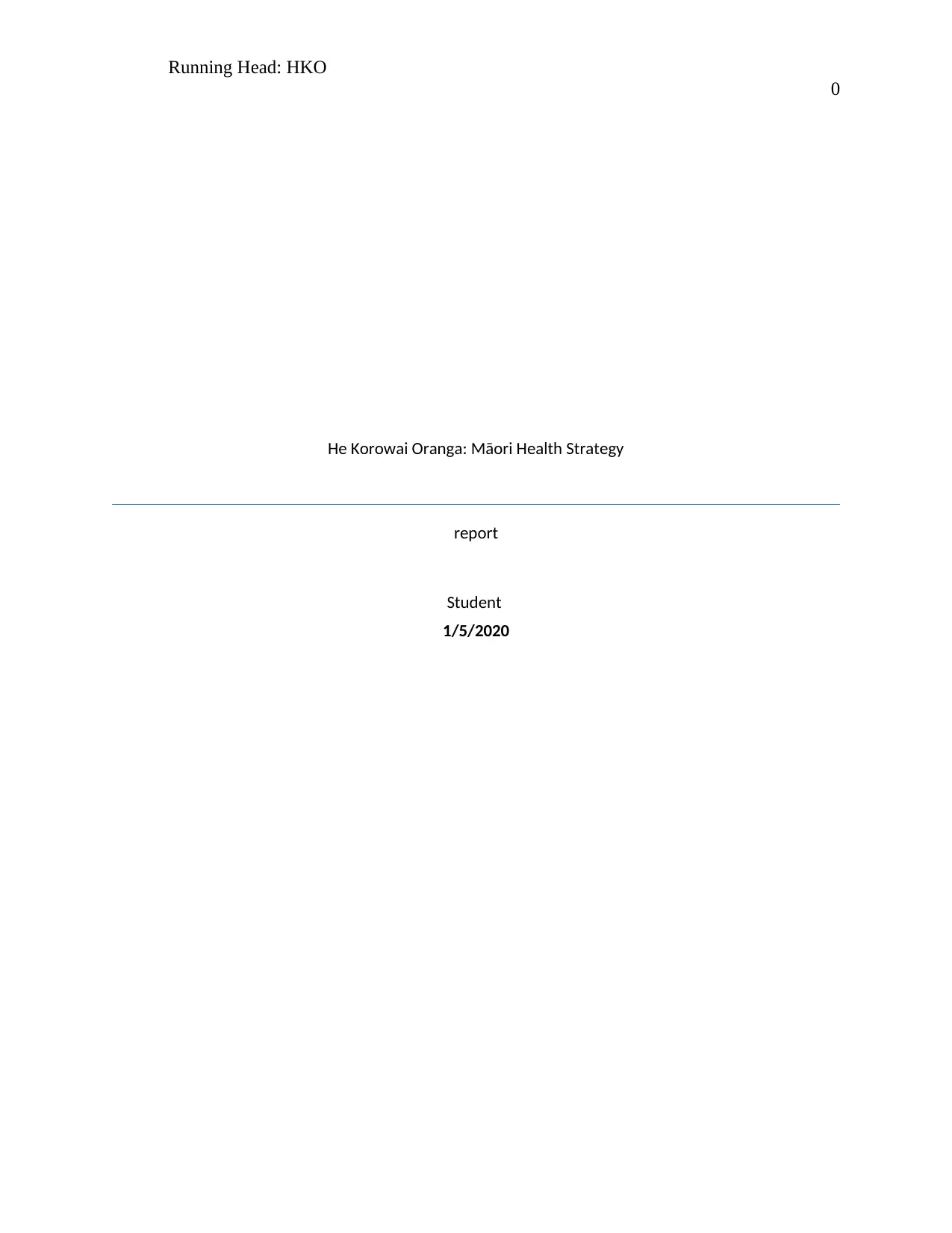
Running Head: HKO
0
He Korowai Oranga: Māori Health Strategy
report
Student
1/5/2020
0
He Korowai Oranga: Māori Health Strategy
report
Student
1/5/2020
Paraphrase This Document
Need a fresh take? Get an instant paraphrase of this document with our AI Paraphraser
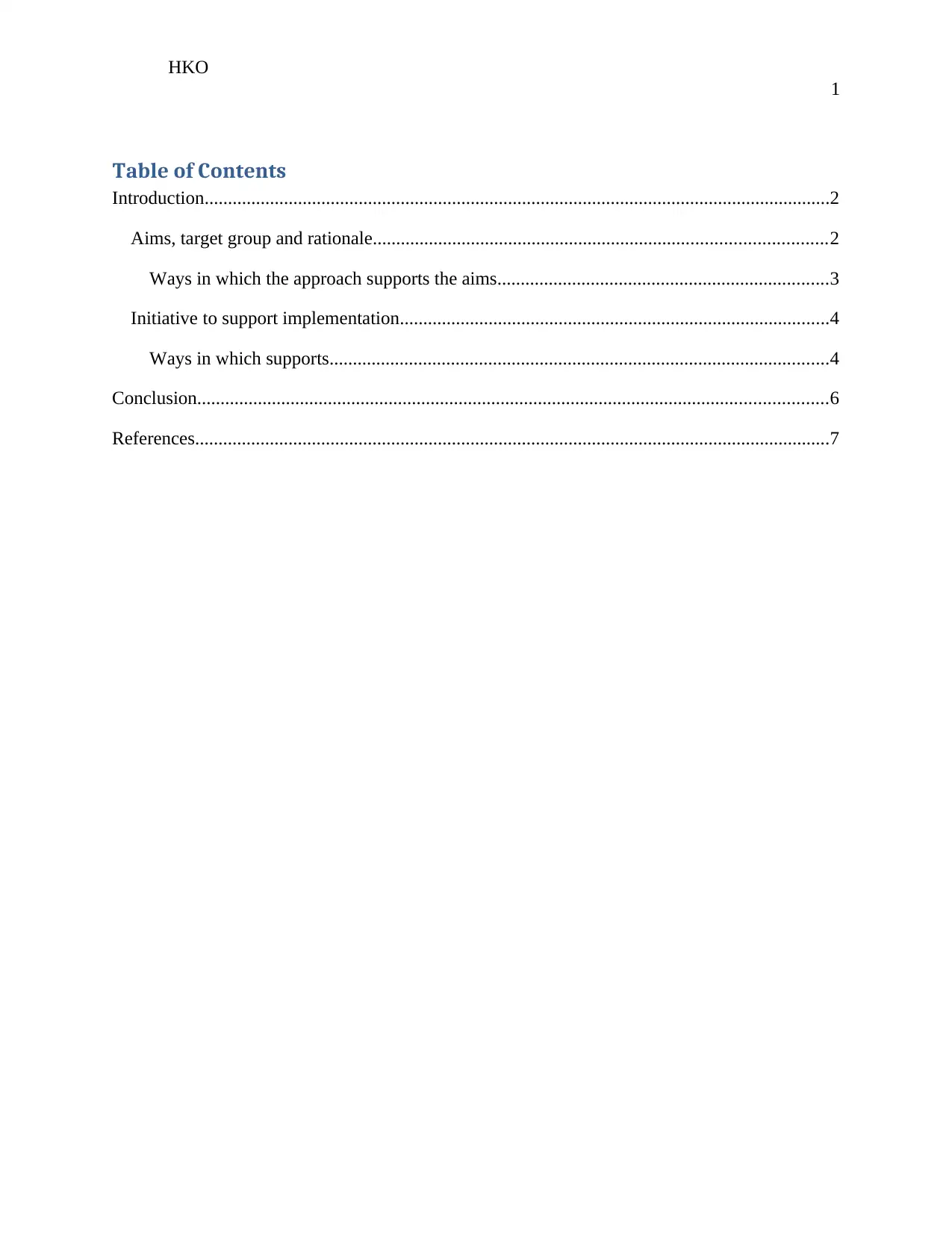
HKO
1
Table of Contents
Introduction......................................................................................................................................2
Aims, target group and rationale.................................................................................................2
Ways in which the approach supports the aims.......................................................................3
Initiative to support implementation............................................................................................4
Ways in which supports...........................................................................................................4
Conclusion.......................................................................................................................................6
References........................................................................................................................................7
1
Table of Contents
Introduction......................................................................................................................................2
Aims, target group and rationale.................................................................................................2
Ways in which the approach supports the aims.......................................................................3
Initiative to support implementation............................................................................................4
Ways in which supports...........................................................................................................4
Conclusion.......................................................................................................................................6
References........................................................................................................................................7
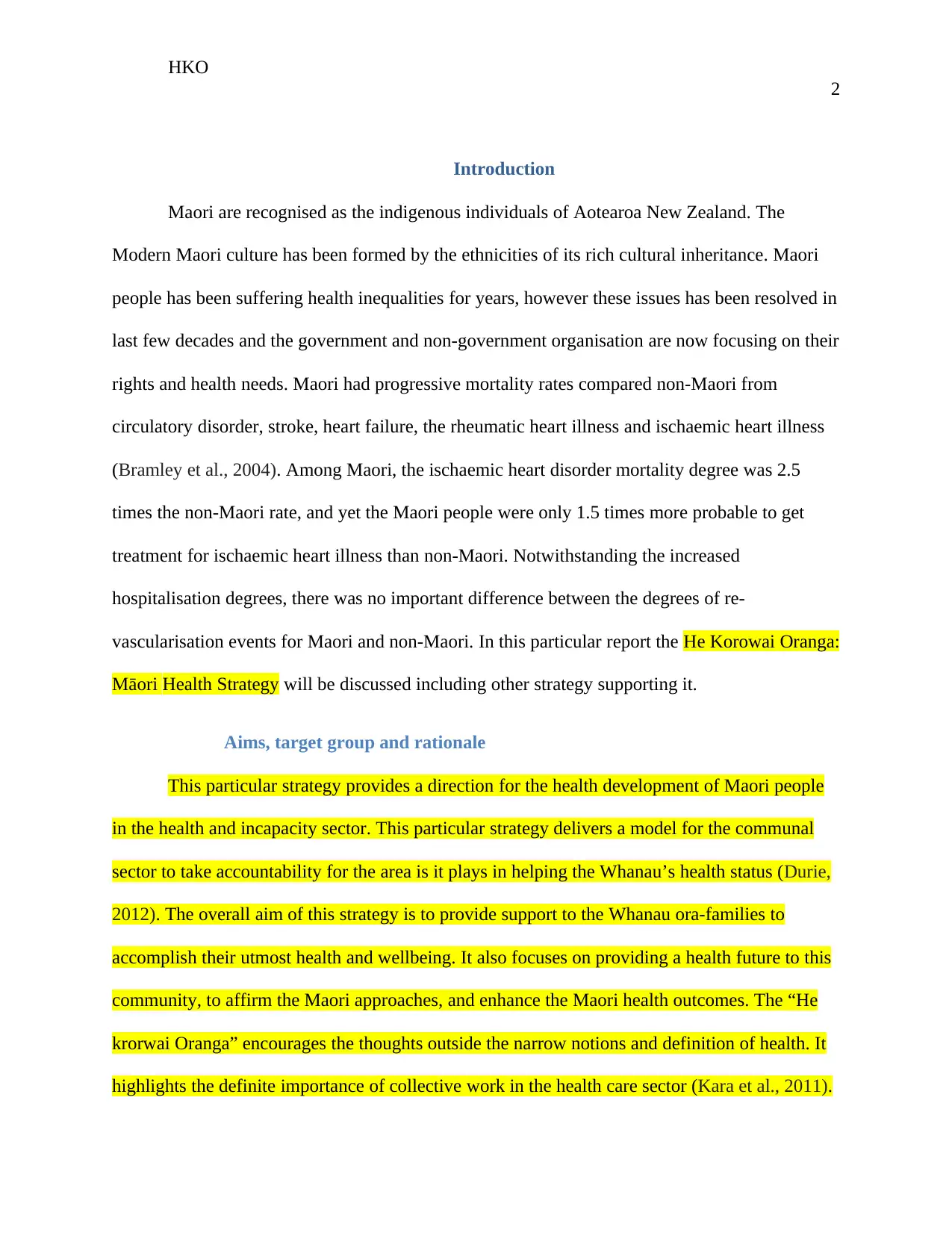
HKO
2
Introduction
Maori are recognised as the indigenous individuals of Aotearoa New Zealand. The
Modern Maori culture has been formed by the ethnicities of its rich cultural inheritance. Maori
people has been suffering health inequalities for years, however these issues has been resolved in
last few decades and the government and non-government organisation are now focusing on their
rights and health needs. Maori had progressive mortality rates compared non-Maori from
circulatory disorder, stroke, heart failure, the rheumatic heart illness and ischaemic heart illness
(Bramley et al., 2004). Among Maori, the ischaemic heart disorder mortality degree was 2.5
times the non-Maori rate, and yet the Maori people were only 1.5 times more probable to get
treatment for ischaemic heart illness than non-Maori. Notwithstanding the increased
hospitalisation degrees, there was no important difference between the degrees of re-
vascularisation events for Maori and non-Maori. In this particular report the He Korowai Oranga:
Māori Health Strategy will be discussed including other strategy supporting it.
Aims, target group and rationale
This particular strategy provides a direction for the health development of Maori people
in the health and incapacity sector. This particular strategy delivers a model for the communal
sector to take accountability for the area is it plays in helping the Whanau’s health status (Durie,
2012). The overall aim of this strategy is to provide support to the Whanau ora-families to
accomplish their utmost health and wellbeing. It also focuses on providing a health future to this
community, to affirm the Maori approaches, and enhance the Maori health outcomes. The “He
krorwai Oranga” encourages the thoughts outside the narrow notions and definition of health. It
highlights the definite importance of collective work in the health care sector (Kara et al., 2011).
2
Introduction
Maori are recognised as the indigenous individuals of Aotearoa New Zealand. The
Modern Maori culture has been formed by the ethnicities of its rich cultural inheritance. Maori
people has been suffering health inequalities for years, however these issues has been resolved in
last few decades and the government and non-government organisation are now focusing on their
rights and health needs. Maori had progressive mortality rates compared non-Maori from
circulatory disorder, stroke, heart failure, the rheumatic heart illness and ischaemic heart illness
(Bramley et al., 2004). Among Maori, the ischaemic heart disorder mortality degree was 2.5
times the non-Maori rate, and yet the Maori people were only 1.5 times more probable to get
treatment for ischaemic heart illness than non-Maori. Notwithstanding the increased
hospitalisation degrees, there was no important difference between the degrees of re-
vascularisation events for Maori and non-Maori. In this particular report the He Korowai Oranga:
Māori Health Strategy will be discussed including other strategy supporting it.
Aims, target group and rationale
This particular strategy provides a direction for the health development of Maori people
in the health and incapacity sector. This particular strategy delivers a model for the communal
sector to take accountability for the area is it plays in helping the Whanau’s health status (Durie,
2012). The overall aim of this strategy is to provide support to the Whanau ora-families to
accomplish their utmost health and wellbeing. It also focuses on providing a health future to this
community, to affirm the Maori approaches, and enhance the Maori health outcomes. The “He
krorwai Oranga” encourages the thoughts outside the narrow notions and definition of health. It
highlights the definite importance of collective work in the health care sector (Kara et al., 2011).
⊘ This is a preview!⊘
Do you want full access?
Subscribe today to unlock all pages.

Trusted by 1+ million students worldwide
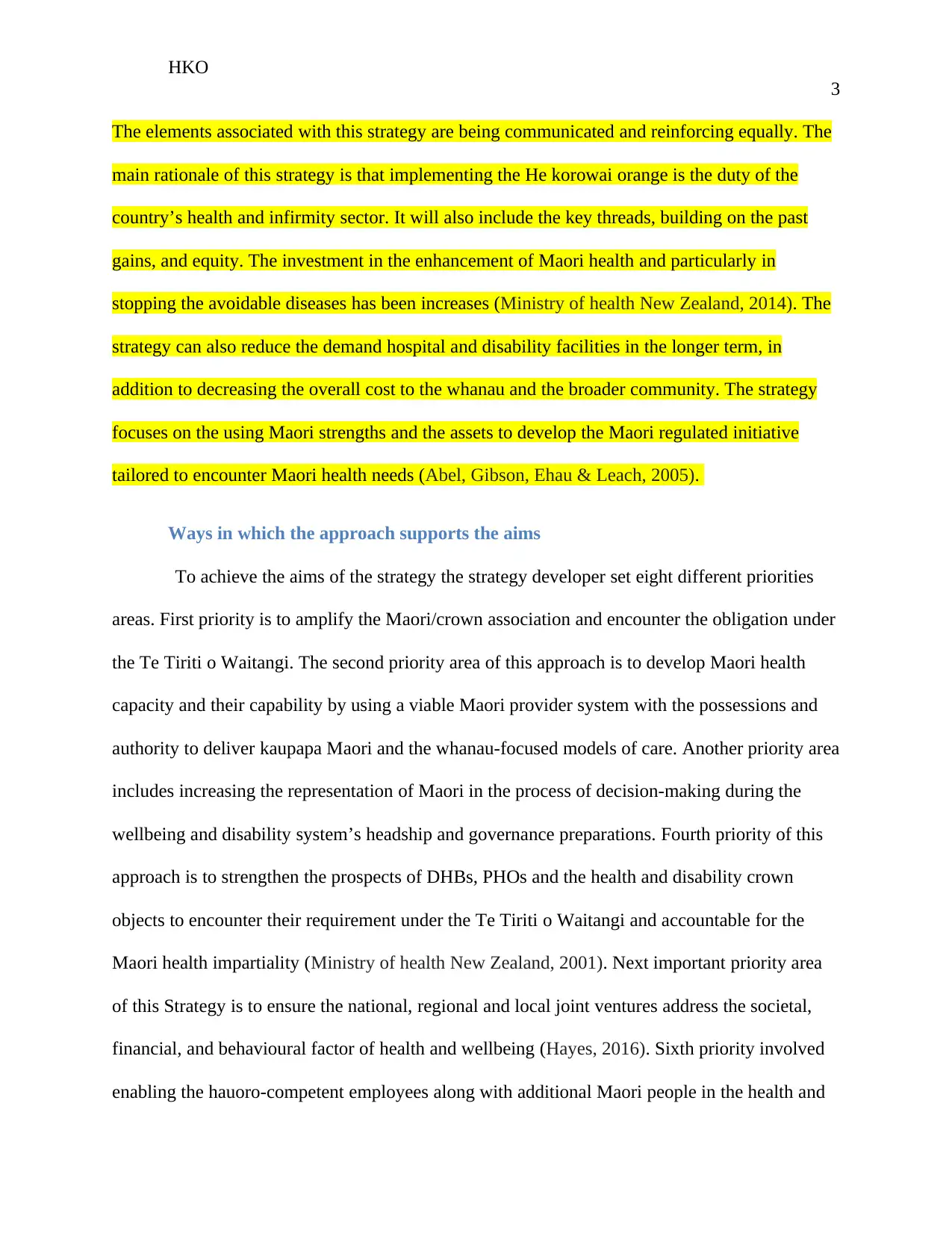
HKO
3
The elements associated with this strategy are being communicated and reinforcing equally. The
main rationale of this strategy is that implementing the He korowai orange is the duty of the
country’s health and infirmity sector. It will also include the key threads, building on the past
gains, and equity. The investment in the enhancement of Maori health and particularly in
stopping the avoidable diseases has been increases (Ministry of health New Zealand, 2014). The
strategy can also reduce the demand hospital and disability facilities in the longer term, in
addition to decreasing the overall cost to the whanau and the broader community. The strategy
focuses on the using Maori strengths and the assets to develop the Maori regulated initiative
tailored to encounter Maori health needs (Abel, Gibson, Ehau & Leach, 2005).
Ways in which the approach supports the aims
To achieve the aims of the strategy the strategy developer set eight different priorities
areas. First priority is to amplify the Maori/crown association and encounter the obligation under
the Te Tiriti o Waitangi. The second priority area of this approach is to develop Maori health
capacity and their capability by using a viable Maori provider system with the possessions and
authority to deliver kaupapa Maori and the whanau-focused models of care. Another priority area
includes increasing the representation of Maori in the process of decision-making during the
wellbeing and disability system’s headship and governance preparations. Fourth priority of this
approach is to strengthen the prospects of DHBs, PHOs and the health and disability crown
objects to encounter their requirement under the Te Tiriti o Waitangi and accountable for the
Maori health impartiality (Ministry of health New Zealand, 2001). Next important priority area
of this Strategy is to ensure the national, regional and local joint ventures address the societal,
financial, and behavioural factor of health and wellbeing (Hayes, 2016). Sixth priority involved
enabling the hauoro-competent employees along with additional Maori people in the health and
3
The elements associated with this strategy are being communicated and reinforcing equally. The
main rationale of this strategy is that implementing the He korowai orange is the duty of the
country’s health and infirmity sector. It will also include the key threads, building on the past
gains, and equity. The investment in the enhancement of Maori health and particularly in
stopping the avoidable diseases has been increases (Ministry of health New Zealand, 2014). The
strategy can also reduce the demand hospital and disability facilities in the longer term, in
addition to decreasing the overall cost to the whanau and the broader community. The strategy
focuses on the using Maori strengths and the assets to develop the Maori regulated initiative
tailored to encounter Maori health needs (Abel, Gibson, Ehau & Leach, 2005).
Ways in which the approach supports the aims
To achieve the aims of the strategy the strategy developer set eight different priorities
areas. First priority is to amplify the Maori/crown association and encounter the obligation under
the Te Tiriti o Waitangi. The second priority area of this approach is to develop Maori health
capacity and their capability by using a viable Maori provider system with the possessions and
authority to deliver kaupapa Maori and the whanau-focused models of care. Another priority area
includes increasing the representation of Maori in the process of decision-making during the
wellbeing and disability system’s headship and governance preparations. Fourth priority of this
approach is to strengthen the prospects of DHBs, PHOs and the health and disability crown
objects to encounter their requirement under the Te Tiriti o Waitangi and accountable for the
Maori health impartiality (Ministry of health New Zealand, 2001). Next important priority area
of this Strategy is to ensure the national, regional and local joint ventures address the societal,
financial, and behavioural factor of health and wellbeing (Hayes, 2016). Sixth priority involved
enabling the hauoro-competent employees along with additional Maori people in the health and
Paraphrase This Document
Need a fresh take? Get an instant paraphrase of this document with our AI Paraphraser
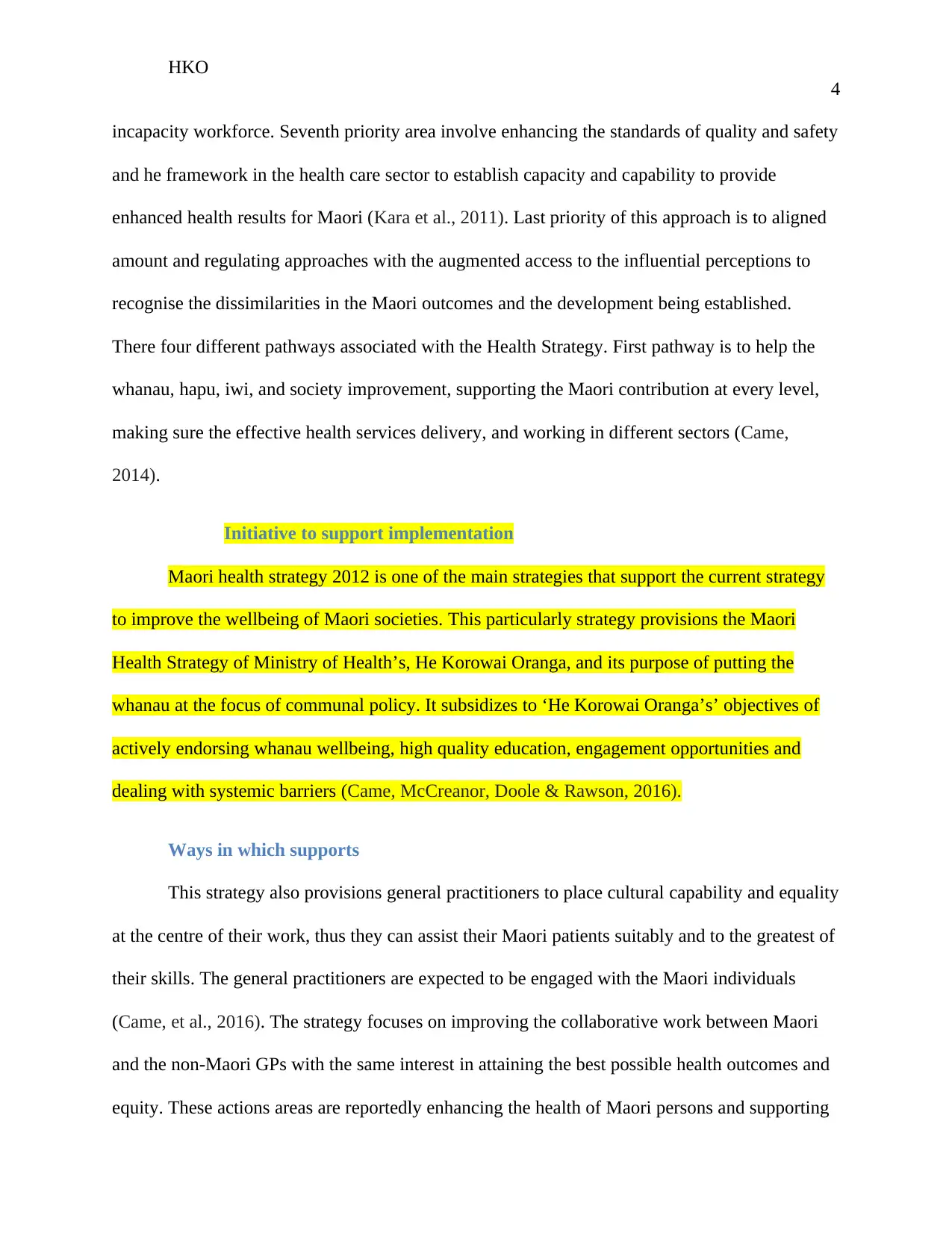
HKO
4
incapacity workforce. Seventh priority area involve enhancing the standards of quality and safety
and he framework in the health care sector to establish capacity and capability to provide
enhanced health results for Maori (Kara et al., 2011). Last priority of this approach is to aligned
amount and regulating approaches with the augmented access to the influential perceptions to
recognise the dissimilarities in the Maori outcomes and the development being established.
There four different pathways associated with the Health Strategy. First pathway is to help the
whanau, hapu, iwi, and society improvement, supporting the Maori contribution at every level,
making sure the effective health services delivery, and working in different sectors (Came,
2014).
Initiative to support implementation
Maori health strategy 2012 is one of the main strategies that support the current strategy
to improve the wellbeing of Maori societies. This particularly strategy provisions the Maori
Health Strategy of Ministry of Health’s, He Korowai Oranga, and its purpose of putting the
whanau at the focus of communal policy. It subsidizes to ‘He Korowai Oranga’s’ objectives of
actively endorsing whanau wellbeing, high quality education, engagement opportunities and
dealing with systemic barriers (Came, McCreanor, Doole & Rawson, 2016).
Ways in which supports
This strategy also provisions general practitioners to place cultural capability and equality
at the centre of their work, thus they can assist their Maori patients suitably and to the greatest of
their skills. The general practitioners are expected to be engaged with the Maori individuals
(Came, et al., 2016). The strategy focuses on improving the collaborative work between Maori
and the non-Maori GPs with the same interest in attaining the best possible health outcomes and
equity. These actions areas are reportedly enhancing the health of Maori persons and supporting
4
incapacity workforce. Seventh priority area involve enhancing the standards of quality and safety
and he framework in the health care sector to establish capacity and capability to provide
enhanced health results for Maori (Kara et al., 2011). Last priority of this approach is to aligned
amount and regulating approaches with the augmented access to the influential perceptions to
recognise the dissimilarities in the Maori outcomes and the development being established.
There four different pathways associated with the Health Strategy. First pathway is to help the
whanau, hapu, iwi, and society improvement, supporting the Maori contribution at every level,
making sure the effective health services delivery, and working in different sectors (Came,
2014).
Initiative to support implementation
Maori health strategy 2012 is one of the main strategies that support the current strategy
to improve the wellbeing of Maori societies. This particularly strategy provisions the Maori
Health Strategy of Ministry of Health’s, He Korowai Oranga, and its purpose of putting the
whanau at the focus of communal policy. It subsidizes to ‘He Korowai Oranga’s’ objectives of
actively endorsing whanau wellbeing, high quality education, engagement opportunities and
dealing with systemic barriers (Came, McCreanor, Doole & Rawson, 2016).
Ways in which supports
This strategy also provisions general practitioners to place cultural capability and equality
at the centre of their work, thus they can assist their Maori patients suitably and to the greatest of
their skills. The general practitioners are expected to be engaged with the Maori individuals
(Came, et al., 2016). The strategy focuses on improving the collaborative work between Maori
and the non-Maori GPs with the same interest in attaining the best possible health outcomes and
equity. These actions areas are reportedly enhancing the health of Maori persons and supporting
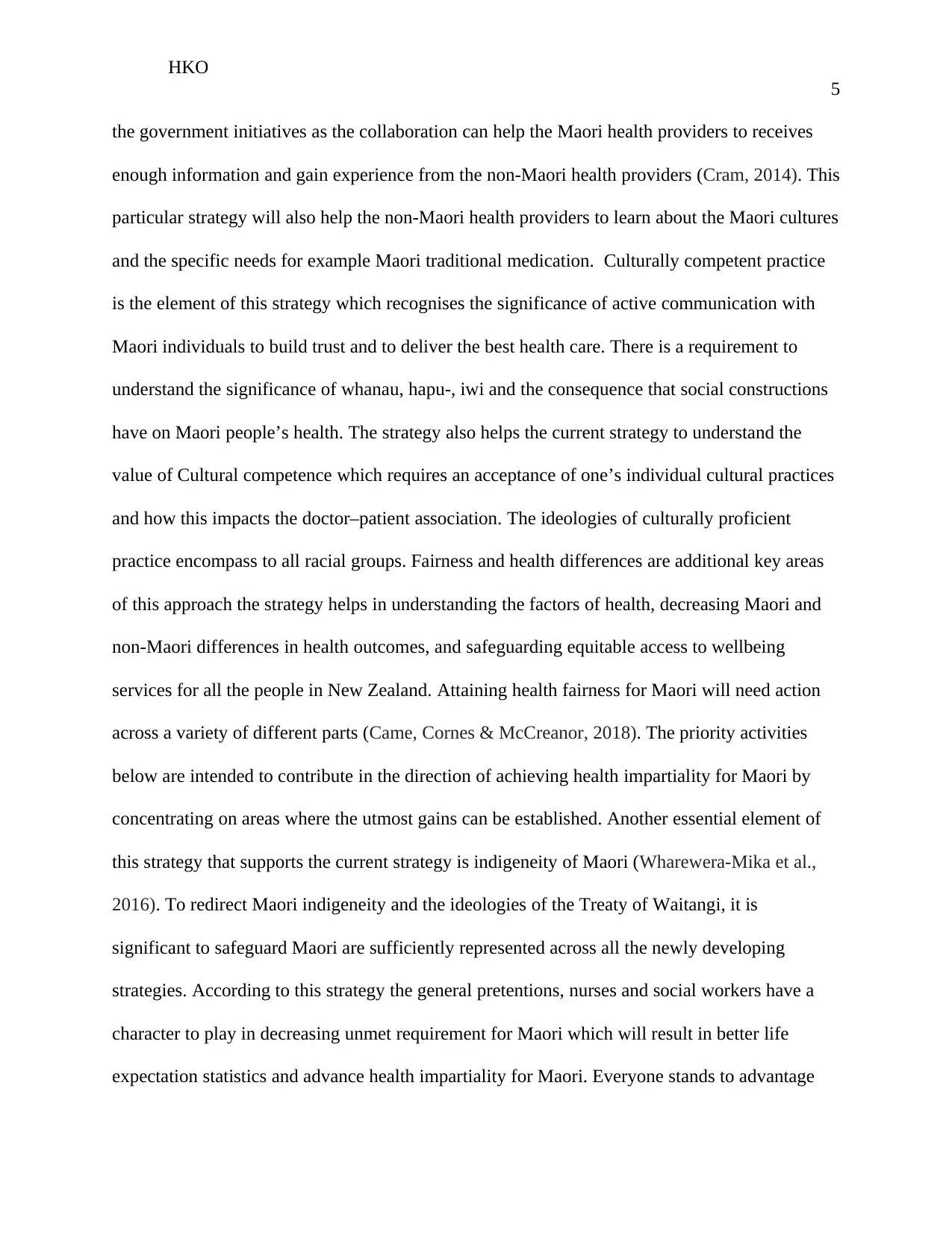
HKO
5
the government initiatives as the collaboration can help the Maori health providers to receives
enough information and gain experience from the non-Maori health providers (Cram, 2014). This
particular strategy will also help the non-Maori health providers to learn about the Maori cultures
and the specific needs for example Maori traditional medication. Culturally competent practice
is the element of this strategy which recognises the significance of active communication with
Maori individuals to build trust and to deliver the best health care. There is a requirement to
understand the significance of whanau, hapu-, iwi and the consequence that social constructions
have on Maori people’s health. The strategy also helps the current strategy to understand the
value of Cultural competence which requires an acceptance of one’s individual cultural practices
and how this impacts the doctor–patient association. The ideologies of culturally proficient
practice encompass to all racial groups. Fairness and health differences are additional key areas
of this approach the strategy helps in understanding the factors of health, decreasing Maori and
non-Maori differences in health outcomes, and safeguarding equitable access to wellbeing
services for all the people in New Zealand. Attaining health fairness for Maori will need action
across a variety of different parts (Came, Cornes & McCreanor, 2018). The priority activities
below are intended to contribute in the direction of achieving health impartiality for Maori by
concentrating on areas where the utmost gains can be established. Another essential element of
this strategy that supports the current strategy is indigeneity of Maori (Wharewera‐Mika et al.,
2016). To redirect Maori indigeneity and the ideologies of the Treaty of Waitangi, it is
significant to safeguard Maori are sufficiently represented across all the newly developing
strategies. According to this strategy the general pretentions, nurses and social workers have a
character to play in decreasing unmet requirement for Maori which will result in better life
expectation statistics and advance health impartiality for Maori. Everyone stands to advantage
5
the government initiatives as the collaboration can help the Maori health providers to receives
enough information and gain experience from the non-Maori health providers (Cram, 2014). This
particular strategy will also help the non-Maori health providers to learn about the Maori cultures
and the specific needs for example Maori traditional medication. Culturally competent practice
is the element of this strategy which recognises the significance of active communication with
Maori individuals to build trust and to deliver the best health care. There is a requirement to
understand the significance of whanau, hapu-, iwi and the consequence that social constructions
have on Maori people’s health. The strategy also helps the current strategy to understand the
value of Cultural competence which requires an acceptance of one’s individual cultural practices
and how this impacts the doctor–patient association. The ideologies of culturally proficient
practice encompass to all racial groups. Fairness and health differences are additional key areas
of this approach the strategy helps in understanding the factors of health, decreasing Maori and
non-Maori differences in health outcomes, and safeguarding equitable access to wellbeing
services for all the people in New Zealand. Attaining health fairness for Maori will need action
across a variety of different parts (Came, Cornes & McCreanor, 2018). The priority activities
below are intended to contribute in the direction of achieving health impartiality for Maori by
concentrating on areas where the utmost gains can be established. Another essential element of
this strategy that supports the current strategy is indigeneity of Maori (Wharewera‐Mika et al.,
2016). To redirect Maori indigeneity and the ideologies of the Treaty of Waitangi, it is
significant to safeguard Maori are sufficiently represented across all the newly developing
strategies. According to this strategy the general pretentions, nurses and social workers have a
character to play in decreasing unmet requirement for Maori which will result in better life
expectation statistics and advance health impartiality for Maori. Everyone stands to advantage
⊘ This is a preview!⊘
Do you want full access?
Subscribe today to unlock all pages.

Trusted by 1+ million students worldwide
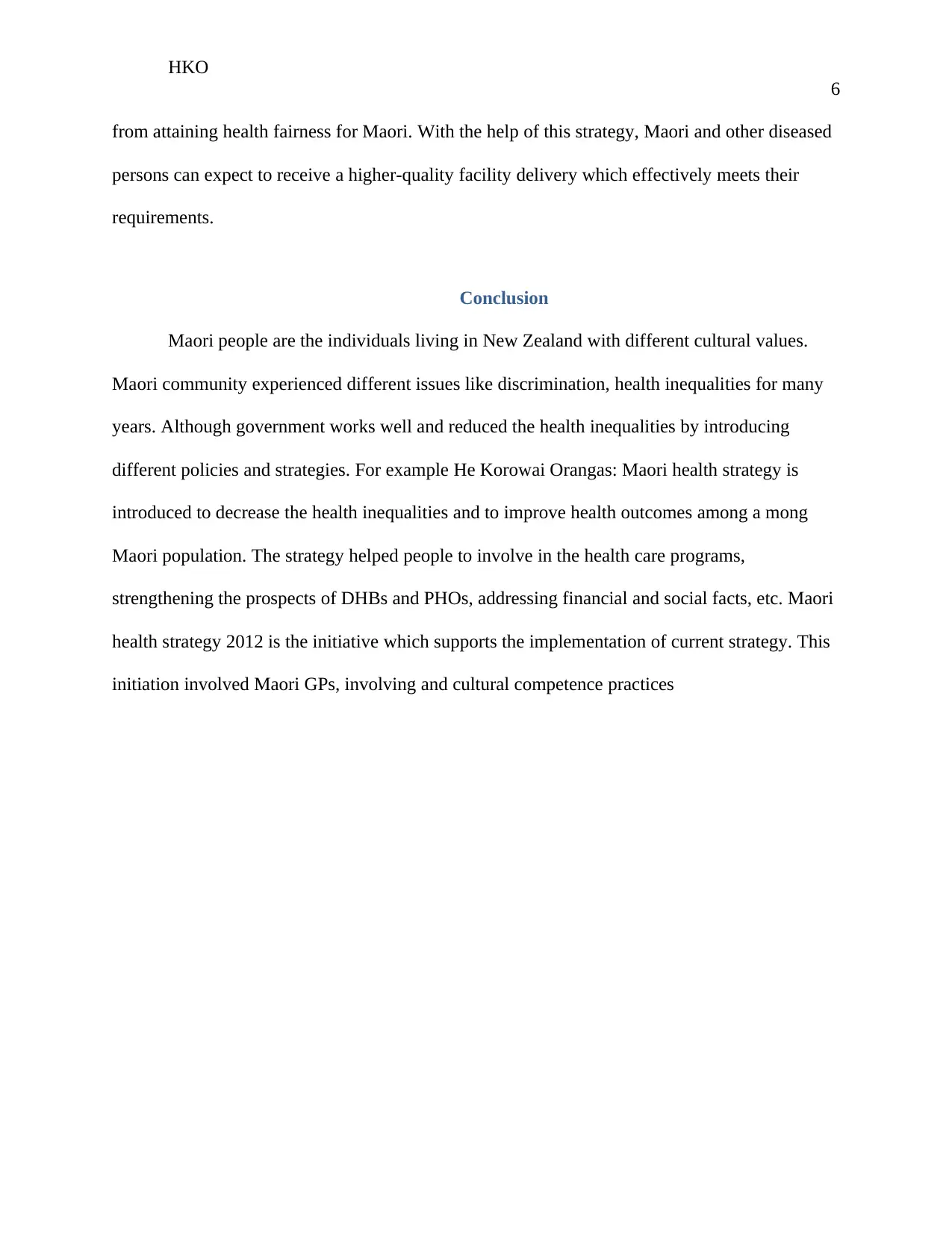
HKO
6
from attaining health fairness for Maori. With the help of this strategy, Maori and other diseased
persons can expect to receive a higher-quality facility delivery which effectively meets their
requirements.
Conclusion
Maori people are the individuals living in New Zealand with different cultural values.
Maori community experienced different issues like discrimination, health inequalities for many
years. Although government works well and reduced the health inequalities by introducing
different policies and strategies. For example He Korowai Orangas: Maori health strategy is
introduced to decrease the health inequalities and to improve health outcomes among a mong
Maori population. The strategy helped people to involve in the health care programs,
strengthening the prospects of DHBs and PHOs, addressing financial and social facts, etc. Maori
health strategy 2012 is the initiative which supports the implementation of current strategy. This
initiation involved Maori GPs, involving and cultural competence practices
6
from attaining health fairness for Maori. With the help of this strategy, Maori and other diseased
persons can expect to receive a higher-quality facility delivery which effectively meets their
requirements.
Conclusion
Maori people are the individuals living in New Zealand with different cultural values.
Maori community experienced different issues like discrimination, health inequalities for many
years. Although government works well and reduced the health inequalities by introducing
different policies and strategies. For example He Korowai Orangas: Maori health strategy is
introduced to decrease the health inequalities and to improve health outcomes among a mong
Maori population. The strategy helped people to involve in the health care programs,
strengthening the prospects of DHBs and PHOs, addressing financial and social facts, etc. Maori
health strategy 2012 is the initiative which supports the implementation of current strategy. This
initiation involved Maori GPs, involving and cultural competence practices
Paraphrase This Document
Need a fresh take? Get an instant paraphrase of this document with our AI Paraphraser
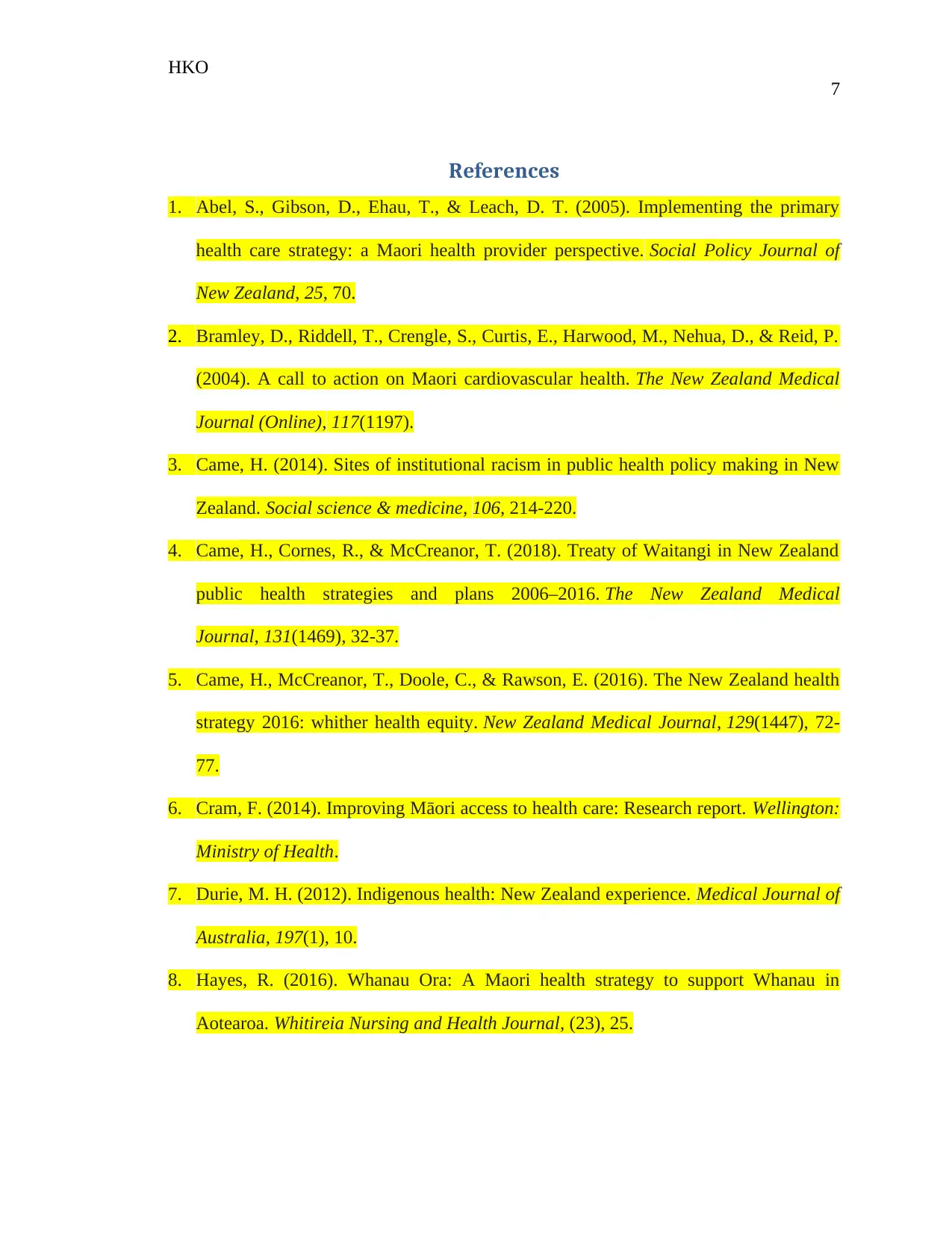
HKO
7
References
1. Abel, S., Gibson, D., Ehau, T., & Leach, D. T. (2005). Implementing the primary
health care strategy: a Maori health provider perspective. Social Policy Journal of
New Zealand, 25, 70.
2. Bramley, D., Riddell, T., Crengle, S., Curtis, E., Harwood, M., Nehua, D., & Reid, P.
(2004). A call to action on Maori cardiovascular health. The New Zealand Medical
Journal (Online), 117(1197).
3. Came, H. (2014). Sites of institutional racism in public health policy making in New
Zealand. Social science & medicine, 106, 214-220.
4. Came, H., Cornes, R., & McCreanor, T. (2018). Treaty of Waitangi in New Zealand
public health strategies and plans 2006–2016. The New Zealand Medical
Journal, 131(1469), 32-37.
5. Came, H., McCreanor, T., Doole, C., & Rawson, E. (2016). The New Zealand health
strategy 2016: whither health equity. New Zealand Medical Journal, 129(1447), 72-
77.
6. Cram, F. (2014). Improving Māori access to health care: Research report. Wellington:
Ministry of Health.
7. Durie, M. H. (2012). Indigenous health: New Zealand experience. Medical Journal of
Australia, 197(1), 10.
8. Hayes, R. (2016). Whanau Ora: A Maori health strategy to support Whanau in
Aotearoa. Whitireia Nursing and Health Journal, (23), 25.
7
References
1. Abel, S., Gibson, D., Ehau, T., & Leach, D. T. (2005). Implementing the primary
health care strategy: a Maori health provider perspective. Social Policy Journal of
New Zealand, 25, 70.
2. Bramley, D., Riddell, T., Crengle, S., Curtis, E., Harwood, M., Nehua, D., & Reid, P.
(2004). A call to action on Maori cardiovascular health. The New Zealand Medical
Journal (Online), 117(1197).
3. Came, H. (2014). Sites of institutional racism in public health policy making in New
Zealand. Social science & medicine, 106, 214-220.
4. Came, H., Cornes, R., & McCreanor, T. (2018). Treaty of Waitangi in New Zealand
public health strategies and plans 2006–2016. The New Zealand Medical
Journal, 131(1469), 32-37.
5. Came, H., McCreanor, T., Doole, C., & Rawson, E. (2016). The New Zealand health
strategy 2016: whither health equity. New Zealand Medical Journal, 129(1447), 72-
77.
6. Cram, F. (2014). Improving Māori access to health care: Research report. Wellington:
Ministry of Health.
7. Durie, M. H. (2012). Indigenous health: New Zealand experience. Medical Journal of
Australia, 197(1), 10.
8. Hayes, R. (2016). Whanau Ora: A Maori health strategy to support Whanau in
Aotearoa. Whitireia Nursing and Health Journal, (23), 25.
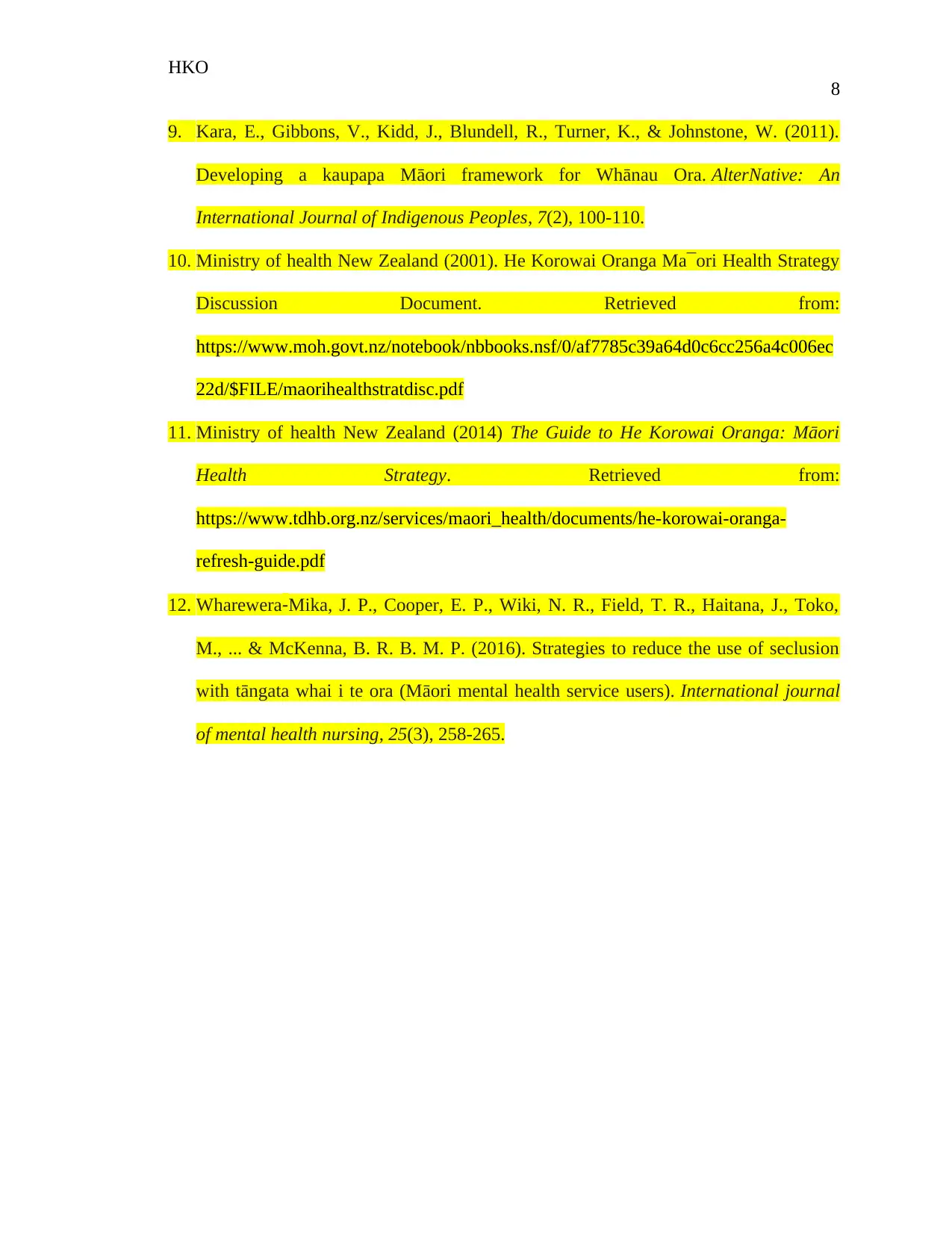
HKO
8
9. Kara, E., Gibbons, V., Kidd, J., Blundell, R., Turner, K., & Johnstone, W. (2011).
Developing a kaupapa Māori framework for Whānau Ora. AlterNative: An
International Journal of Indigenous Peoples, 7(2), 100-110.
10. Ministry of health New Zealand (2001). He Korowai Oranga Ma¯ori Health Strategy
Discussion Document. Retrieved from:
https://www.moh.govt.nz/notebook/nbbooks.nsf/0/af7785c39a64d0c6cc256a4c006ec
22d/$FILE/maorihealthstratdisc.pdf
11. Ministry of health New Zealand (2014) The Guide to He Korowai Oranga: Māori
Health Strategy. Retrieved from:
https://www.tdhb.org.nz/services/maori_health/documents/he-korowai-oranga-
refresh-guide.pdf
12. Wharewera‐Mika, J. P., Cooper, E. P., Wiki, N. R., Field, T. R., Haitana, J., Toko,
M., ... & McKenna, B. R. B. M. P. (2016). Strategies to reduce the use of seclusion
with tāngata whai i te ora (Māori mental health service users). International journal
of mental health nursing, 25(3), 258-265.
8
9. Kara, E., Gibbons, V., Kidd, J., Blundell, R., Turner, K., & Johnstone, W. (2011).
Developing a kaupapa Māori framework for Whānau Ora. AlterNative: An
International Journal of Indigenous Peoples, 7(2), 100-110.
10. Ministry of health New Zealand (2001). He Korowai Oranga Ma¯ori Health Strategy
Discussion Document. Retrieved from:
https://www.moh.govt.nz/notebook/nbbooks.nsf/0/af7785c39a64d0c6cc256a4c006ec
22d/$FILE/maorihealthstratdisc.pdf
11. Ministry of health New Zealand (2014) The Guide to He Korowai Oranga: Māori
Health Strategy. Retrieved from:
https://www.tdhb.org.nz/services/maori_health/documents/he-korowai-oranga-
refresh-guide.pdf
12. Wharewera‐Mika, J. P., Cooper, E. P., Wiki, N. R., Field, T. R., Haitana, J., Toko,
M., ... & McKenna, B. R. B. M. P. (2016). Strategies to reduce the use of seclusion
with tāngata whai i te ora (Māori mental health service users). International journal
of mental health nursing, 25(3), 258-265.
⊘ This is a preview!⊘
Do you want full access?
Subscribe today to unlock all pages.

Trusted by 1+ million students worldwide
1 out of 9
Related Documents
Your All-in-One AI-Powered Toolkit for Academic Success.
+13062052269
info@desklib.com
Available 24*7 on WhatsApp / Email
![[object Object]](/_next/static/media/star-bottom.7253800d.svg)
Unlock your academic potential
Copyright © 2020–2025 A2Z Services. All Rights Reserved. Developed and managed by ZUCOL.




